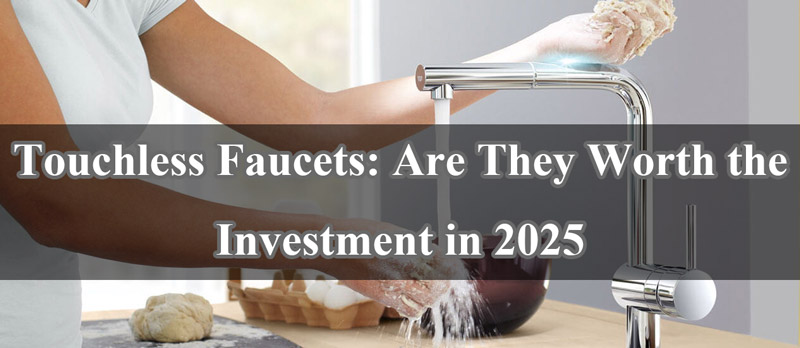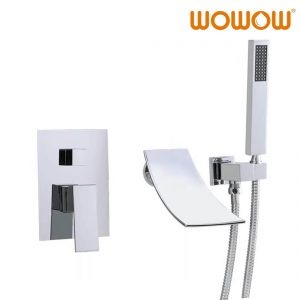
In 2025, the modern home is increasingly defined by technology-driven conveniences that enhance functionality and sustainability. One of the most prominent innovations in this arena is the touchless faucet, a fixture that has evolved from a luxury to a more accessible option for homeowners across the globe. As touchless faucets become more advanced, they raise an important question: Are they worth the investment? Let’s explore the benefits, drawbacks, and practical considerations of touchless faucets in 2025 to determine whether they’re a smart choice for your home.
What Are Touchless Faucets?
Touchless faucets use motion-sensing technology to control the flow of water, allowing users to turn the faucet on or off without ever touching it. This is achieved through an infrared sensor that detects motion in front of the faucet. When a user’s hands, or an object, is placed near the sensor, the faucet activates, and when the hands move away, the water stops flowing.
Initially seen as a high-tech feature reserved for public restrooms, touchless faucets have rapidly made their way into residential kitchens and bathrooms. In 2025, they offer a combination of convenience, hygiene, and sustainability that appeals to a growing number of homeowners.
Benefits of Touchless Faucets
1. Enhanced Hygiene
One of the most compelling reasons to invest in a touchless faucet is hygiene. In kitchens and bathrooms, faucets are some of the most frequently touched surfaces in the home. Traditional faucets can harbor germs and bacteria, especially in high-use areas like the kitchen. With a touchless faucet, you can avoid direct contact with the faucet’s handles, minimizing the spread of germs, bacteria, and other contaminants.
This feature is particularly appealing for families with young children or individuals with health concerns, as the reduced need to touch faucets helps keep surfaces cleaner and reduces the potential for cross-contamination.
2. Convenience and Ease of Use
In a busy household, having one less thing to touch when cooking or washing hands is a major convenience. With a touchless faucet, you can turn on the water without having to touch the handle, which is especially helpful when your hands are messy, covered in food, or full of groceries. The faucet turns on and off automatically as you approach or move away, creating a seamless experience.
In the kitchen, this can be a game-changer when you’re preparing food and need to rinse your hands or ingredients quickly. In the bathroom, it offers a similar level of convenience for handwashing, especially when you’re rushing or when kids are involved.
3. Water Conservation
Another reason touchless faucets are gaining popularity in 2025 is their ability to help conserve water. Many touchless faucets come equipped with built-in sensors that regulate the flow of water, ensuring that it only runs when needed and automatically shutting off once the task is completed. This feature can help reduce water waste by preventing the faucet from being left on accidentally, which is especially beneficial in water-scarce areas.
Some models are designed with flow rate adjustments, allowing homeowners to limit the water flow, thus further contributing to water conservation efforts. With growing concerns about water usage, touchless faucets offer an effective solution for reducing household consumption.
4. Improved Aesthetics and Design
Touchless faucets often come in sleek, modern designs that elevate the look of your kitchen or bathroom. As faucet technology evolves, manufacturers are focusing on aesthetic details, offering a variety of styles, finishes, and configurations that suit different interior design preferences. From minimalist, high-arc faucets to elegant, low-profile options, there’s a touchless faucet design to match any home decor.
In 2025, many touchless faucets are not only functional but also visually appealing, complementing contemporary kitchens and bathrooms where form and function are equally important.
Drawbacks of Touchless Faucets
1. Higher Initial Cost
One of the biggest drawbacks of touchless faucets is the initial cost. While traditional faucets can be quite affordable, touchless models generally come with a premium price tag due to the added technology and features. Depending on the brand and model, you can expect to pay anywhere from $150 to $600 or more for a touchless faucet in 2025, compared to as little as $50 for a standard faucet.
For homeowners on a budget, this can make touchless faucets less accessible, especially if multiple faucets are needed throughout the home. Additionally, the installation cost may be higher, especially if plumbing modifications are required to accommodate the technology.
2. Battery or Power Source Maintenance
Touchless faucets are powered by batteries or, in some cases, by a direct power connection. The battery life typically ranges from six months to a year, depending on usage. While some high-end models are designed to be more energy-efficient, homeowners still need to regularly check and replace the batteries to ensure the faucet functions properly. In 2025, some newer models are integrating more sustainable power sources like solar panels, but battery replacement remains a key consideration.
For homeowners who prefer low-maintenance appliances, the need for periodic battery changes can be a slight inconvenience. Moreover, power failure or battery depletion can disrupt the faucet’s function, which can be frustrating in the middle of cooking or cleaning.
3. Potential for Sensor Malfunctions
Like any technology, touchless faucets come with the risk of malfunctioning sensors. If the sensor becomes obstructed by dirt, soap buildup, or other debris, it may fail to detect movement properly, resulting in the faucet either not turning on or off. While this issue can usually be solved with regular cleaning and maintenance, it may cause inconvenience in the short term.
Additionally, environmental factors such as excessive moisture or heat can sometimes interfere with sensor performance. For instance, a steam-filled bathroom could cause a faucet to activate unintentionally.
4. Limited Compatibility with Existing Plumbing
Although touchless faucets are becoming more versatile, there can still be compatibility issues with older plumbing systems. Some models require specific water pressure levels or additional modifications to work properly. It’s important to ensure that the plumbing in your home can support the faucet’s requirements to avoid costly adjustments during installation.
Are They Worth It?
In 2025, the decision to invest in a touchless faucet depends on your priorities and lifestyle. If you value convenience, hygiene, and water conservation, a touchless faucet could be a worthwhile investment. The added cost can often be justified by the long-term savings on water bills and the reduced need for cleaning, especially in households where multiple people are using the kitchen or bathroom throughout the day.
On the other hand, if you’re working with a tight budget or are less concerned with the advanced features, a traditional faucet may be sufficient for your needs. For homeowners in older homes or those with more limited plumbing setups, the installation challenges and potential for sensor malfunctions may be additional factors to weigh.
Ultimately, touchless faucets offer significant benefits, but whether they’re worth the investment in 2025 depends on your personal preferences, budget, and home setup. With ongoing advancements in technology, these faucets will only continue to evolve, making them an increasingly attractive option for many homeowners.
 WOWOW Faucets
WOWOW Faucets







您好!Please sign in